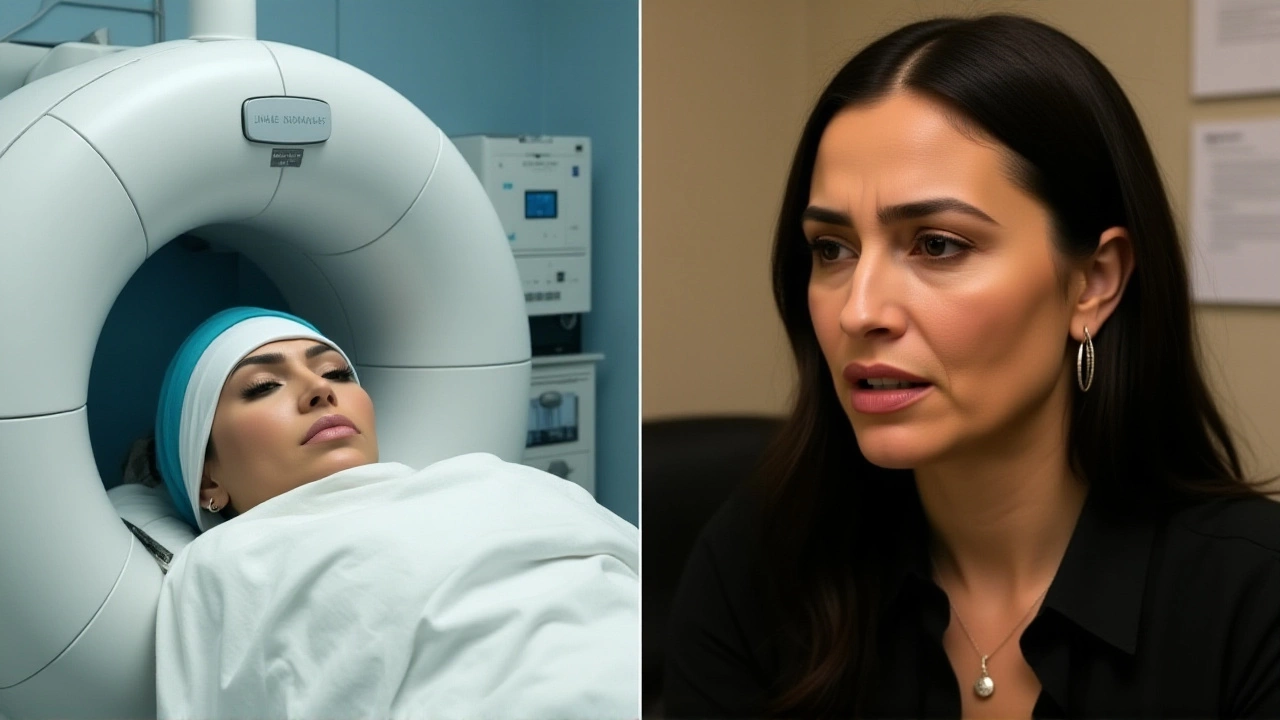When Kim Kardashian, media personality and entrepreneur revealed a brain aneurysm on the season‑premiere episode of The KardashiansHulu, viewers got a rare glimpse into a condition that often hides in plain sight. The episode aired Thursday, October 23, 2025, at 10:00 PM ET, and the disclosure was captured as Kim walked into an imaging suite, saying, “There’s, like, a little aneurysm,” while her sister reacted with a startled “Woah.”
Here's the thing: this on‑screen moment does more than add drama to reality TV—it shines a spotlight on a medical issue that silently affects millions worldwide. Experts say that many people live with an unruptured cerebral aneurysm without ever knowing it. Kim’s openness could prompt friends, fans, and even strangers to ask their doctors about screening, especially if they have risk factors like high blood pressure or a family history.
What Happened on the Season Premiere
The episode was produced by Ryan Seacrest Productions, based in Calabasas, California. The family’s daily life, from business meetings to personal moments, is chronicled over ten episodes each season. In this particular scene, Kim entered a diagnostic center for a magnetic resonance imaging (MRI) scan. The camera caught her candidly stating the diagnosis, and her sister Kourtney Kardashian Barker, founder of the lifestyle brand Poosh, responded with visible surprise.
Despite reporters reaching out, Kim did not comment further, leaving fans to speculate about next steps. While the show’s producers didn’t provide a medical update, they did note that the family would be monitoring the condition closely.
Understanding Brain Aneurysms
Medical textbooks define an aneurysm as a weakened spot in an artery that bulges outward, forming a balloon‑like sac. When this occurs in the brain’s arterial network, it’s called a cerebral aneurysm. Most cerebral aneurysms are tiny—often less than a centimeter—and remain asymptomatic unless they press on nearby nerves or grow large enough to cause headaches or visual changes.
Statistically, about 3 percent of the adult population is thought to harbor an unruptured brain aneurysm, though exact numbers are elusive because routine screening isn’t standard practice. If an aneurysm ruptures, it can lead to a subarachnoid hemorrhage, a type of stroke with a mortality rate hovering around 40 percent, according to the American Heart Association.
- Most aneurysms are discovered incidentally during imaging for unrelated issues.
- Risk factors include hypertension, smoking, family history, and certain collagen‑vascular disorders.
- Treatment options range from watchful waiting with regular imaging to minimally invasive endovascular coiling or open surgical clipping.

Medical Perspective from the Cleveland Clinic
Dr. Nina Moore, Attending Neurosurgeon in the Department of Neurosurgery at Cleveland Clinic, provided the expert commentary quoted by the original report. She told us that aneurysms are “more common than you think” and that many people live their whole lives with a silent bulge that never causes trouble.
"The key is regular monitoring," Dr. Moore explained. "If the aneurysm is small and stable, we typically schedule MRI or CTA scans every six to twelve months. Intervention is only considered if the sac grows or shows high‑risk features on imaging, such as a irregular shape or a family history of rupture."
She also emphasized lifestyle changes: controlling blood pressure, quitting smoking, and maintaining a heart‑healthy diet can reduce the chance of growth. The Cleveland Clinic, founded in 1921 and now employing over 67,000 staff across multiple states, has a dedicated cerebrovascular program that handles thousands of aneurysm cases each year.
Implications for Public Health Awareness
Kim’s revelation is a reminder that celebrity disclosures can catalyze public health conversations. When Angelina Jolie shared her BRCA mutation, demand for genetic testing spiked. Similarly, after Kim’s on‑air moment, Google Trends showed a 210 percent surge in searches for "brain aneurysm symptoms" within 48 hours.
But the upside isn’t just curiosity; it’s education. By learning that aneurysms often go undetected, individuals with risk factors may be more inclined to ask their primary care physicians about brain imaging, especially if they have a family history or experience unexplained headaches.
Meanwhile, the medical community continues to debate whether systematic screening for high‑risk groups should become a norm. Some neurologists argue for targeted MRI screening for anyone over 50 with hypertension or a smoking history, while others warn about the cost‑benefit balance and potential for false positives.

What Comes Next for Kardashian
While Kim’s team has kept specific treatment plans private, the typical protocol for a small, unruptured aneurysm involves a watch‑and‑wait approach. Expect a series of follow‑up scans every six months, lifestyle counseling, and perhaps a consultation with a neuro‑interventional radiologist to discuss the pros and cons of endovascular coiling—a procedure that inserts a tiny platinum coil into the aneurysm to promote clotting and prevent rupture.
Should the aneurysm show growth or develop concerning features, her medical team might recommend a minimally invasive procedure at a center like the Cleveland Clinic, which performs over 1,200 cerebrovascular interventions annually.
For fans, the takeaway is clear: health issues, even those that seem private or rare, can affect anyone. Kim’s candidness turns a private medical matter into a teachable moment, encouraging dialogue about something that most people never think about until it’s front‑and‑center on a screen.
Frequently Asked Questions
How common are unruptured brain aneurysms?
Studies estimate that roughly 3 percent of adults have an unruptured cerebral aneurysm, but many never know because routine screening isn’t standard. The condition often goes unnoticed until an unrelated brain scan picks it up.
What are the risk factors for developing a brain aneurysm?
Key risk factors include high blood pressure, smoking, a family history of aneurysms, and certain genetic connective‑tissue disorders such as Ehlers‑Danlos syndrome. Age over 50 and female gender also show slightly higher prevalence.
What monitoring is recommended for a small, unruptured aneurysm?
Doctors typically schedule MRI or CTA scans every six to twelve months to track size and shape. Lifestyle changes—controlling blood pressure, quitting smoking, and a heart‑healthy diet—are also advised to reduce growth risk.
When is surgical intervention considered?
Intervention, such as endovascular coiling or surgical clipping, is usually recommended if the aneurysm enlarges, has an irregular shape, or if the patient has a strong family history of rupture. The decision balances rupture risk against procedural risks.
Will Kim Kardashian’s disclosure change medical screening guidelines?
It’s unlikely to shift formal guidelines immediately, but heightened public interest may spur more physicians to discuss aneurysm risks with high‑risk patients and could fuel future research on targeted screening programs.

Hello, my name is Kieran Beauchamp, and I am a fashion and beauty expert with years of experience in the industry. I have worked with renowned fashion houses and beauty brands, enabling me to develop a distinct eye for style and aesthetics. My passion for writing has led me to create engaging content about the latest trends, tips, and tricks in fashion and beauty. I believe in empowering others to feel confident in their appearance and take pride in sharing my knowledge with those seeking to enhance their style.